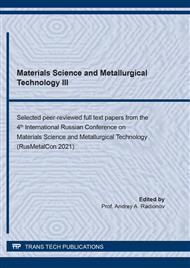[1]
M. Katancik, S. Mirzababaei, M. Ghayoor, S. Pasebani, Selective laser melting and tempering of H13 tool steel for rapid tooling applications, Journal of Alloys and Compounds. 849 (2020) 156319.
DOI: 10.1016/j.jallcom.2020.156319
Google Scholar
[2]
P. Lapouge, J. Dirrenberger, F. Coste, M. Schneider, Laser heat treatment of martensitic steel and dual-phase steel with high martensite content, Materials Science and Engineering: A. 752 (2019) 128-135.
DOI: 10.1016/j.msea.2019.03.016
Google Scholar
[3]
V.R. Sagar, K. Wärmefjord, R. Söderberg, Geometrical variation from selective laser heat treatment of boron steels, Procedia CIRP. 75 (2018) 409-414.
DOI: 10.1016/j.procir.2018.04.062
Google Scholar
[4]
S. Roy, J. Zhao, P. Shrotriya, S. Sundararajan, Effect of laser treatment parameters on surface modification and tribological behavior of AISI 8620 steel, Tribology International. 112 (2017) 94-102.
DOI: 10.1016/j.triboint.2017.03.036
Google Scholar
[5]
D.A. Lesyk, S. Martinez, B.N. Mordyuk, V.V. Dzhemelinskyi, A. Lamikiz, G.I. Prokopenko, Effects of laser heat treatment combined with ultrasonic impact treatment on the surface topography and hardness of carbon steel AISI 1045, Optics & Laser Technology. 111 (2019) 424-438.
DOI: 10.1016/j.optlastec.2018.09.030
Google Scholar
[6]
D.A. Lesyk, S. Martinez, B.N. Mordyuk, V.V. Dzhemelinskyi, A. Lamikiz, G.I. Prokopenko, Yu.V. Milman, K.E. Grinkevych, Microstructure related enhancement in wear resistance of tool steel AISI D2 by applying laser heat treatment followed by ultrasonic impact treatment, Surface and Coatings Technology. 328 (2017) 344-354.
DOI: 10.1016/j.surfcoat.2017.08.045
Google Scholar
[7]
M.L. Bernstein, V.N. Pustovojt, Heat Treatment of Steel Products in Magnetic Field, Mashinostroenie, Moscow, (1987).
Google Scholar
[8]
V.D. Sadovskiy, T.I. Tabatchikova, V.M. Umova, Influence of hardened steel production on the process of recrystallization at laser heating, The Physics of Metals and Metal Science. 58(4) (1984) 812-817.
Google Scholar
[9]
Ch. Li, Zh. Yuan, Y. Fan, Sh. He, W. Xuan, X. Li, Y. Zhong, Z. Ren, Microstructure and mechanical properties of a Ni-based superalloy after heat treatment in a steady magnetic field, Journal of Materials Processing Technology. 246 (2017) 176-184.
DOI: 10.1016/j.jmatprotec.2017.03.018
Google Scholar
[10]
Q. Cai, C. Zhai , Q. Luo, T.-Y. Zhang, Q. Li, Effects of magnetic field on the microstructure and mechanical property of Mg-Al-Gd alloys, Materials Characterization. 154 (2019) 233-240.
DOI: 10.1016/j.matchar.2019.06.011
Google Scholar
[11]
V.D. Sadovskiy, L.V. Smirnov, Y.P. Romanov, The influence of a permanent magnetic field on diffusion decay of supercooled austenite, The Physics of Metals and Metal Science. 46(2) (1978) 54-55.
Google Scholar
[12]
A.P. Gyl'ayev, Superplasticity of Steel, Metallurgija, Moscow, (1982).
Google Scholar
[13]
A.V. Brover, The device of contactless registration of temperature of the metal, varied with hyperhigh speed, Strengthening Technologies and Coatings. 3 (2007) 53-56.
Google Scholar
[14]
V.N. Pustovojt, Yu.V. Dolgachev, Yu.A. Kornilov, Unstable of the crystalline lattice before martensite transformation and influence of the external magnetic field in these condition, Vestnik of Don State Technical University. 9(2) (2009) 238-248.
Google Scholar
[15]
V.N. Pustovojt, Yu.V. Dolgachev, Special features of the structure of martensite formed by hardening of steel in magnetic field in the temperature range of superplasticity of austenite, Metal Science and Heat Treatment. 11 (2011) 3-7.
DOI: 10.1007/s11041-012-9427-1
Google Scholar
[16]
W. Xuan, L. Du, Y. Han, W. Shao, H. Zhang, J. Wang, Y. Zhong, Z. Ren, Investigation on microstructure and creep properties of nickel based single crystal superalloys PWA1483 during heat treatment under an alternating magnetic field, Materials Science and Engineering: A. 762 (2019) 138087.
DOI: 10.1016/j.msea.2019.138087
Google Scholar
[17]
A. Łaszcz, M. Hasiak, J. Kaleta, Microstructure, magnetism and nanomechanical properties of Ni50Mn25Ga20Gd5 magnetic shape memory alloy before and after heat treatment, Journal of Rare Earths. 37(11) (2019) 1224-1229.
DOI: 10.1016/j.jre.2019.01.004
Google Scholar
[18]
Y. Dong, S. Shuai, J. Yu, W. Xuan, Zh. Zhang, J. Wang, Zh. Ren, Effect of high static magnetic field on the microstructure and mechanical properties of directionally solidified alloy 2024, Journal of Alloys and Compounds. 749 (2018) 978-989.
DOI: 10.1016/j.jallcom.2018.03.259
Google Scholar
[19]
Sh. Quan, K. Jiajie, X. Zhiguo, W. Haidou, H. Yanfei, M. Guozheng, L. Haipeng, Effect of pulsed magnetic field treatment on the residual stress of 20Cr2Ni4A steel, Journal of Magnetism and Magnetic Materials. 476 (2019) 218-224.
DOI: 10.1016/j.jmmm.2018.12.105
Google Scholar
[20]
V.S. Kovalenko, D.F. Dauw, Ways to intensify laser hardening technology, CIRP Annals. 47(1) (1998) 133-136.
DOI: 10.1016/s0007-8506(07)62882-0
Google Scholar


